Monday 28 March 2011
The Lesser Flamingo - The Littlest One
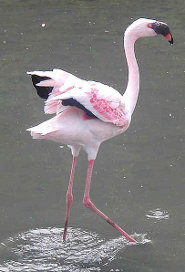
The
lesser flamingo (
Phoeniconaias minor) is the smallest of the four types of flamingos, weighing in at an average 4.5 pounds (2.0 kg). They stand just about 3 feet (1 m) tall with an equal wingspan. They look similar to the Caribbean flamingo, with the long legs and neck, and the hooked bill but are generally a lighter pink.
The lesser flamingos’ range runs from southern to eastern Africa and into southwest Asia, and they can primarily be found in areas with brackish water or salty lakes and lagoons. They feed in these areas by holding their bill upside down in the water and filtering out algae and small insects. Their diet consists mainly of spirulina algae, which causes the birds feathers to turn pink, but they also will eat small shrimp if they catch them in their filters.
For breeding, they travel in large flocks to just a handful of different breeding sites. In Africa there is Lake Natron in Tanzania, as well as Etosha Pan, Sua Pan and Kamfers Dam. In northwestern India they use the two salt pans, Zinzuwadia and Purabcheria. Although the lesser flamingo gathers in large, noisy flocks, they do form a monogamous couple and both the male and female will take turns tending to the single egg that is laid. Once the egg hatches, the chicks will gather in crèches. These groups, sometimes growing into the hundreds of thousands, are watched over by just a few of the adult lesser flamingos. The adults will then help lead the chicks across land, crossing distances up to 20 miles (32 km) to get to fresh water.
Their natural predators are the marabou stork and several types of vultures, which go after their chicks and eggs. The mature lesser flamingo is preyed upon by baboons and wildcats, including
lions,
leopards, and
cheetahs. The greatest threats to the lesser flamingo however are
humans and their development. The lesser flamingo is considered to be at “Near-Threatened” status. Even though, at nearly 2 million, they are the most numerous of all the four types of flamingos, their breeding grounds and habitats are slowly being either taken over or polluted by development. Current plans to develop a soda ash extraction plant near Lake Natron, the largest of the African breeding grounds, could cause the lesser flamingos’ threat level to be worsened.
You can help spreading the word about this animal by liking it on facebook
Permanent Link
Friday 25 March 2011
Golden spiny mouse - Every mother's child
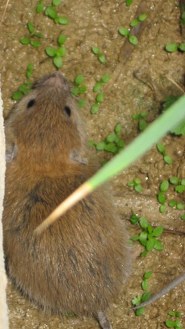
The
Golden spiny mouse (
Acomys russatus) is extraordinary in more ways than one. It is one of the relatively few animals that can switch from being diurnal or active during daytime to nocturnal and active at night. It is believed that since the Golden spiny mouse is not a combative animal, and often coexists with members of its same genus, it uses this ability to change to day or night activity so it does not have to compete for its food and other means of survival.
Still another trait that makes the Golden spiny mouse unique is the fact that it uses the "nanny" arrangement after the birth of its young. Most other animals care for their own newly born litters, but females of this species will actually nurse and care for the babies other females. So, in a way, a baby mouse is every mother's child. Litters usually consist of two or three but sometimes as many as five babies. They are born following a gestation period of 35 to 45 days. The babies are born completely covered with hair and with their eyes open and usually able to see. After a few days, they will leave the nest and are sexually mature and self sufficient after three months. The Golden spiny mouse typically lives three or four years, but some will live up to five years.
Omnivorous, like most small desert mice, the Golden spiny mouse feeds mostly on seeds, flowers, plants, and a few insects. They are found mostly in Egypt, Saudi Arabia, Jordan, Yemen, Israel, and Pakistan. They prefer terrain like dried up riverbeds and hillsides covered with rocks and boulders where they can get into cracks and crevices to escape predators. Enemies threatening them most are owls and other birds of prey, carnivorous mammals, snakes, and reptiles.
The Golden spiny mouse's average size is about 12.5 centimeters long or approximately 5 inches. Its average weight is around 53 grams or about 2 ounces. It is covered with bristly spines and on its back or dorsal area, the spines are thicker and more plentiful. Its tail is quite brittle and offers another somewhat curious feature. It is easily autotomized, or separated from the rest of the body.
Golden spiny mice seem to be slowly increasing in number. As more
people inhabit the desert regions, their presence creates an extra source of food for this species of mice.
Picture of the golden spiny mouse by שומבלע, licensed under
Creative Commons Attribution-Share Alike 2.5 Generic license.
You can help spreading the word about this animal by liking it on facebook
Permanent Link
Wednesday 23 March 2011
The Desert Pocket Mouse - Don't Add Water
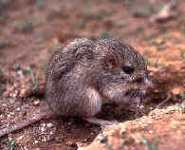
The
desert pocket mouse (
Chaetodipus penicillatus) lives in the desert regions of the southwestern United States, including Nevada, Arizona, parts of New Mexico, Texas and California, the Baja Peninsula and northeastern Mexico. It prefers dry, sandy regions with little vegetation. It's not generally found in rocky areas.
Common desert pocket mouse habitats include dry stream beds, desert washes or arroyos. The little vegetation around may consist of cacti, yucca, mesquite, palo verde or creosote bush.
The desert pocket mouse is a granivore, meaning seeds make up its diet. It burrows into the desert soil to find seeds from grasses or shrubs. It may occasionally supplement its diet with insects. The desert pocket mouse has cheek pouches to store seeds in, and it also builds burrows to store seeds for the winter. In some areas, the desert pocket mouse may go into partial
hibernation for the winter months, waking only often enough to eat stored seeds.
Interestingly, there's no evidence a desert pocket mouse drinks water. It seems to extract as much water as it needs from the seeds it eats. This helps it to live in an arid desert climate.
The average length of a desert pocket mouse is 180 millimeters, or seven inches. Of that length, more than half--about 110 millimeters--is its tail. Average weight varies from 11 to 22 grams, or .39 to .77 ounces. It has coarse fur that's grayish brown on its back and whitish on its underside. It has no lateral line or rump spines. Its feet are whitish, and its hind feet are about 25 millimeters long.
The desert pocket mouse has sharp front incisors that help it to break through hard, dry desert soil to search for buried seeds. They tend to be solitary animals who forage at night. They compete with other members of the Heteromyidae family for food. It has natural predators, such as owls, but is not currently in danger of extinction.
The average lifespan for a desert pocket mouse is just one year whether in the wild or in captivity. During that year, a female may bear one or two litters from early spring to late summer. On average, gestation takes 23 days and a litter consists of four young, though it could be as few as one or as many as seven.
You can help spreading the word about this animal by liking it on facebook
Permanent Link
Monday 14 March 2011
The Mountain Tapir - a Whistling Swimmer
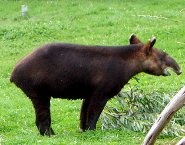
The
Mountain Tapir (
Tapirus pinchaque) lives in South American cloud forests and wetlands high in the Andes mountains of Ecuador, Columbia and Peru. Since they live at altitudes up to 14,000 feet, they might get too cold if not for their woolly coats, which are longer than those of most tapir species. They sometimes migrate with the seasons to avoid the annoyance of certain insects. They are the smallest type of tapir.
Expectant mother Mountain Tapirs have a long wait: It can take 400 days before the baby tapir is born! When they are first born, Mountain Tapirs weigh about twenty-six to thirty kilograms (twelve to fourteen pounds)--that's lighter than a miniature poodle--and grow to be up to 250 kilograms (550 pounds). The adults are about 1.8 meters (six feet) in length, about .8 meters (2.5 to three feet) tall, and solid black or dark brown. The babies are brown with cream-colored spots and stripes over their bodies. They stay with their mothers for a year to eighteen months, and can live up to 30 years. When they are grown, they live alone.
Mountain Tapirs are nocturnal, sleeping during the day and foraging at night. They are well-suited to traversing mountainous terrain and are also excellent swimmers. Their feet spread out when set down and contract when lifted, so that they keep from sinking in mud and have little difficulty pulling out of it. They are so comfortable in water that they often flee to it when threatened. The sound they most often make is a high-pitched whistle which might be mistaken for a bird's chirp.
Sadly, the forests where Mountain Tapirs live are shrinking. The trees are being cut down for lumber and to make room for mining and farming. Experts of the International Union for Conservation of Nature (IUCN) believe that unless the situation changes drastically, the Mountain Tapir may be extinct in a few years. There are only about 2,500 Mountain Tapirs left in the wild, and very few zoos have breeding pairs in captivity.
Humans also threaten the Mountain Tapir more directly: Poachers hunt them for food and their woolly hides, and locals sometimes use various parts of the tapir in home remedies. In addition to poachers, Mountain Tapirs are hunted by
mountain lions,
spectacled bears and
jaguars.
Ferns, grasses, leaves and other plants make up the Mountain Tapir's vegetarian diet. Plant seeds often pass undigested through their systems and grow where they fall. In this way, the tapirs help to renew their own food source.
Picture of the mountain tapir by Elissa Berver, licensed under
Creative Commons Attribution-Share Alike 2.0 Generic license.
You can help spreading the word about this animal by liking it on facebook
Permanent Link
Wednesday 09 March 2011
The Wolf-fish - Antifreeze and Fangs
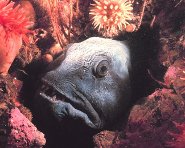
The
wolf-fish (
Anarhichas lupus) is the largest fish of the Anarhichadidae family. They live on both the west and east coasts of the North Atlantic Ocean, Greenland, Britain, Scandinavia, and Iceland, with the most concentrated populations located in the Gulf of Maine. Also known as the ocean catfish, seawolf, or seacat, the wolf-fish is also the most unique of the family.
On average, wolf-fish weigh 10 to 40 pounds (4.5 to 18.1 kilograms), and measure up to 5 feet (150 centimeters) long. Wolf-fish are benthic, meaning they live on the ocean floor, and they are found in water that is anywhere between 250 to 1600 feet deep. Rock formations and caves make the ideal home where the solitary wolf-fish spends most of its time, venturing out primarily just to find food.
The most obvious feature of the wolf-fish would be the protruding canine teeth. Behind these fang-like canine teeth are three rows of smaller crushing teeth, with the middle row containing four pairs of molars. There are also smaller serrated teeth that line the fish’s throat. Using these teeth and an extremely strong jaw, the wolf-fish crush their prey. Prey includes mussels, starfish, sea clams, crabs and other hard-shelled mollusks. The wolf-fish does not eat other fish, and its only known predator is the
Atlantic cod. The wolf-fish also dines on green crabs and sea urchins, whose populations would otherwise increase rapidly and could potentially be harmful to the marine environment.
The large teeth give the fish a very intimidating appearance, but it’s what you don’t see that really sets this fish apart. The wolf-fish produces a type of natural antifreeze that helps to keep their blood flowing and allows them to thrive in such cold waters.
Another unique attribute of the wolf-fish is how they reproduce, along with the large size of the eggs (6.5 mm). Unlike other fish that release their eggs into the open waters before fertilization, wolf-fish eggs are fertilized internally. Spawning generally occurs between November and February. After fertilization, the male acts as the caregiver. He will protect the eggs and newborn wolffish for about four months, until they are strong enough to be independent.
Although not endangered, the wolf-fish is currently a Species of Concern by the National Marine Fisheries Service due to a drastic decrease in population. Over-fishing and recreational fishing have been the major contributing factors to this decrease.
You can help spreading the word about this animal by liking it on facebook
Permanent Link
Monday 07 March 2011
Guinea Pig - the Other White Meat
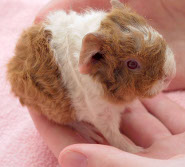
When we think of
guinea pigs (
Cavia porcellus), 'interesting' probably isn't the word that first comes to mind. However, these little creatures commonly kept as children's pets are far from ordinary. In this article, we will explore the reasons why.
Guinea pigs are born with their eyes open (the guinea pig in the picture is only 8 hours old), which is uncommon for most offspring in the animal kingdom. They are also born with a great deal of fur (see picture (!)), which is also abnormal since most animals are bald at birth. It just keeps getting weirder, with the guinea pig being capable of eating solid food from day one. They don't skip milk altogether, but are well able to eat solid food on the very same day they are born.
Despite having such large, orb-like eyes, guinea pigs suffer from rather poor eyesight. Their hearing is very sensitive to make up for the lack of sight. Guinea pigs are really good at swimming despite their sausage shaped bodies. They like to hop, and do so quite frequently when they are happy, but they don't rise very far off the ground. Guinea pigs are unable to climb.
The guinea pig has a rich history of serving as a food source. The first known instance of guinea pig cultivation occurred in 5000 BC in what would be modernly known as Bolivia,
Ecuador, and
Peru. Later, guinea pigs were brought aboard ships by sailors as a portable meat supply. This coupled with their surprising swimming abilities even gave the guinea pig a unique name in Germany: 'Meerschweinchen' which literally translates to 'little sea pig'. The guinea pig is the national dish of Peru to this day, with a whopping 65 million of them consumed on average in a year. Guinea pig, called cuy in Peru, is actually a very healthy meat. It has more protein than beef and less fat too. But the meat is tough and it definitely doesn't taste like chicken.
Guinea pigs are believed to be descended from various closely related species of cavy found living wild in South America. These wild cavies have a social structure similar to cattle, with the cavies living together in herds.
The ideal guinea pig diet is primarily grass, and like humans guinea pigs must get their vitamin C from their food.
Picture of the 8 hour old guinea pig baby by Sandos, licensed under
GNU Free Documentation License.
You can help spreading the word about this animal by liking it on facebook
Permanent Link
Wednesday 02 March 2011
Eastern Cottontail: Common with Large Eyes
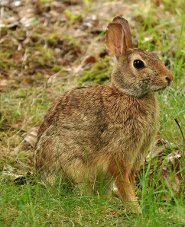
The
Eastern Cottontail (
Sylvilagus floridanus) is a mammal that lives in Canada, the United States, as well as down into South America. It generally prefers living in swamps, thickets and dense forests. The Eastern Cottontail is a very private animal and rarely comes out into open fields, preferring to live in brushy areas.
Adult Eastern Cottontails measure approximately 395 to 477 mm with an average of 430 mm (15.55 to 18.78 inches, average 16.93), while they weigh approximately .80-1.53 kg(1.76 to 3.37 pounds). Generally, the underside of the Eastern Cottontail is white while while the topside has a brown underfur with a longer, more coarse gray and black tipped that covers the back. Compared to other rabbits, it has particularly large eyes.
While the Eastern Cottontails are hard to see because they are quite private, they usually venture out more often in the evening and night hours. When they leave their homes during the night, it is usually to eat. They tend to eat mostly various green plants, grasses, bark from many different trees and other vegetarian foods, especially fruits and vegetables. They have been known to sneak into residential gardens and snack on the home-grown produce. The Eastern Cottontails are preferred by predators such as hawks, owls,
coyotes, foxes, weasels, and eagles. Despite being preyed upon, the Eastern Cottontail move very quickly and can run up to 18 miles per hour and can jump between 10 and 15 feet (3 - 4.5 meters) to avoid becoming dinner. Despite their speed, the average life expectancy of an Eastern Cottontail is very short, lasting usually only one to three years.
The mating ritual of the Eastern Cottontail is quite entertaining if you can catch a glimpse of it. The ritual usually occurs after the sun has gone down for the night and involves the male chasing the female until she decides to turn and face him. At this point, she will slap at him with her front paws, they then crouch down and leap into the air prior to mating. Gestational age is approximately 25 to 28 days and the female usually has between 1 and 7 litters per year, with an average of 4. If you are ever near a brushy area after dark, be sure to check out these amazing animals.
Picture of the Eastern Cottontail by , licensed under The High Fin Sperm Whale, licensed under
Creative Commons Attribution-Share Alike 3.0 Unported license.
You can help spreading the word about this animal by liking it on facebook
Permanent Link
 The lesser flamingo (Phoeniconaias minor) is the smallest of the four types of flamingos, weighing in at an average 4.5 pounds (2.0 kg). They stand just about 3 feet (1 m) tall with an equal wingspan. They look similar to the Caribbean flamingo, with the long legs and neck, and the hooked bill but are generally a lighter pink.
The lesser flamingo (Phoeniconaias minor) is the smallest of the four types of flamingos, weighing in at an average 4.5 pounds (2.0 kg). They stand just about 3 feet (1 m) tall with an equal wingspan. They look similar to the Caribbean flamingo, with the long legs and neck, and the hooked bill but are generally a lighter pink.
 The
The  The
The  The
The  The
The  When we think of
When we think of  The
The